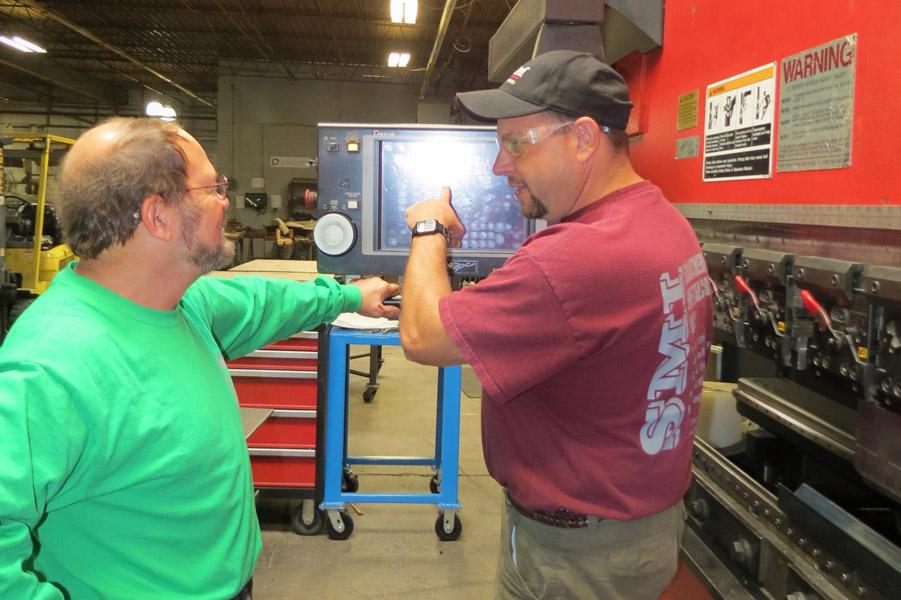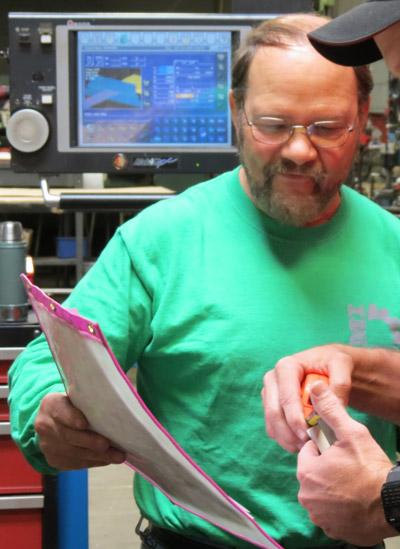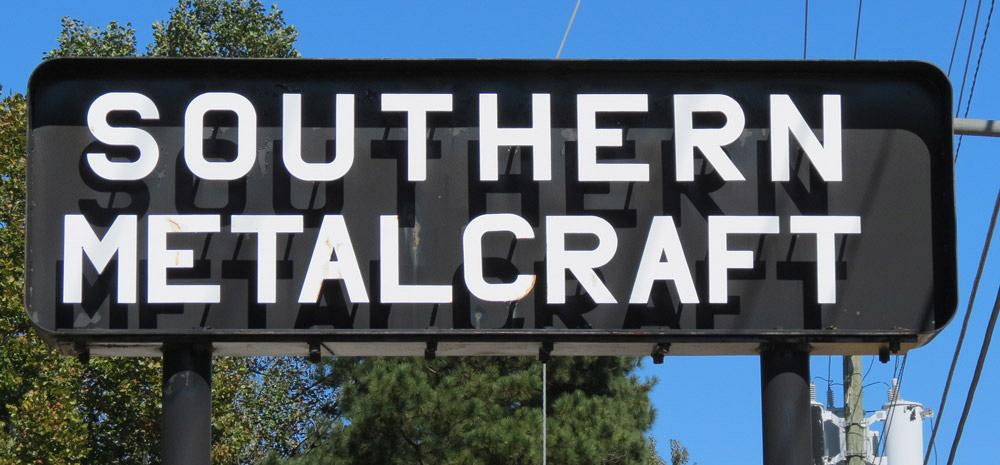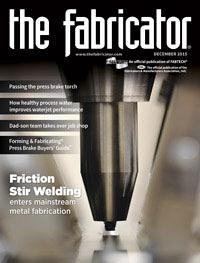Senior Editor
- FMA
- The Fabricator
- FABTECH
- Canadian Metalworking
Categories
- Additive Manufacturing
- Aluminum Welding
- Arc Welding
- Assembly and Joining
- Automation and Robotics
- Bending and Forming
- Consumables
- Cutting and Weld Prep
- Electric Vehicles
- En Español
- Finishing
- Hydroforming
- Laser Cutting
- Laser Welding
- Machining
- Manufacturing Software
- Materials Handling
- Metals/Materials
- Oxyfuel Cutting
- Plasma Cutting
- Power Tools
- Punching and Other Holemaking
- Roll Forming
- Safety
- Sawing
- Shearing
- Shop Management
- Testing and Measuring
- Tube and Pipe Fabrication
- Tube and Pipe Production
- Waterjet Cutting
Industry Directory
Webcasts
Podcasts
FAB 40
Advertise
Subscribe
Account Login
Search
Press brake training: Passing the torch
How one press brake guru is passing on knowledge to the next generation
- By Tim Heston
- December 1, 2015
- Article
- Bending and Forming
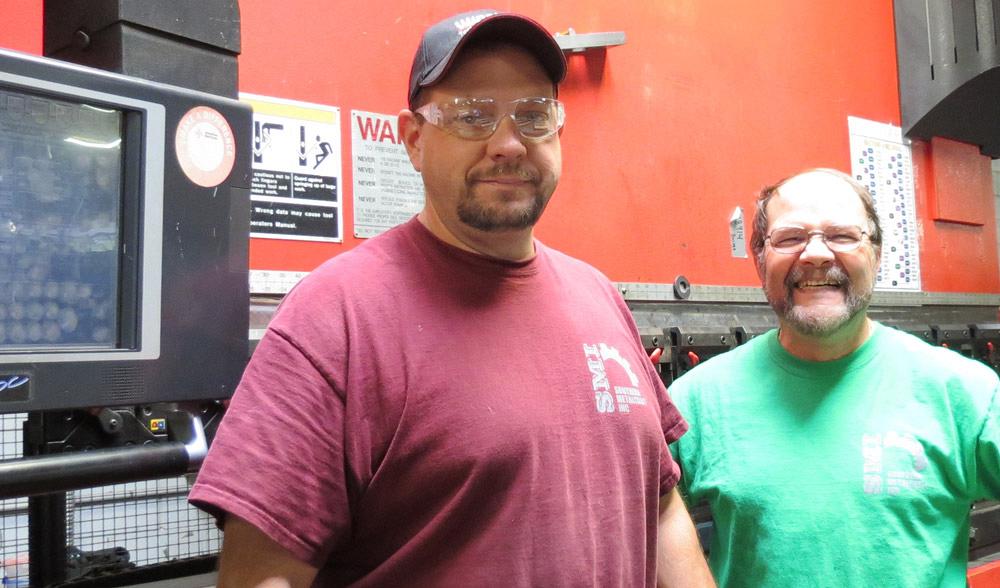
At Southern Metalcraft Inc. in Lithonia, Ga., Dwayne Moon (left) will become press brake lead after the current lead, Tim Kennedy (right), retires at the end of 2016.
Dwayne Moon was duly warned. During his job interview in 2009 at Lithonia, Ga.-based Southern Metalcraft Inc. (SMI), then company Vice President (now President) Greg Williams told Moon about the fabricator’s press brake lead, Tim Kennedy.
Kennedy was (and is) very knowledgeable. After 26 years at SMI, he has gained a feel for what works and what doesn’t. His eyes light up when he senses something is a bit off. Sure enough, it usually is, even if it’s just a few thousandths. He makes minor adjustments, and the part forms right on the money.
Still, for someone with so many years of brake experience, relating to a novice doesn’t come with ease.
As Williams recalled, “I told Dwayne, ‘I’m going to stick you with a guy who’s been here for 20 years. He says he doesn’t want or need a helper, but he needs somebody because we need somebody. It’s not going to be fun, but hang in there.’ I told him, ‘If you can make it a year, you’ll be OK.’”
2016 will be a year of transition for the SMI forming department. Kennedy will be retiring a year from now. Moon, a person who came to the shop six years ago with no metal fabrication experience at all, will be taking over as the press brake lead.
How exactly did this happen, especially considering the shop previously hired a press brake operator with plenty of technical experience?
Kennedy chuckled. “Honestly, despite all the horrible stuff you’re hearing, [Dwayne] is by far the best guy I’ve worked with. Yeah, to be honest, from a technical knowledge perspective, he wasn’t the best at the beginning. The guy who was technically the best at the start was hard to work with. He thought he knew more than he did.”
The two get along, and this quite possibly may be the underlying secret to overcoming what the industry calls the “skilled-labor” crisis. Technical aptitude is important, and Moon certainly has it; before joining SMI, he spent eight years in the pavement industry. But the crisis may not be as much about skill as many think it is. Moon is proof that technical metal fabrication skills can be taught on the job to someone with no previous metalworking experience. Getting along with your co-workers—that’s a different and, in many ways, more important story.
“How Can You Not Know This?”
On his first day, Moon recalled how Kennedy put him on an old Pacific press brake, gave him a string of single-bend jobs, and let him have at it.
“I remember standing there looking at the machine for about 20 minutes,” Moon said. “Tim finally came over and told me which dies to put in and how to look at the print, and we went from there.”
So how did such a rough start lead to such success? In some ways Moon and Kennedy couldn’t be more different. Moon treads carefully, takes notes, asks questions, then asks questions again just to make sure he understood correctly, then goes back to his notebook.
“I would just write down everything he said,” Moon recalled, “and made notes about how parts were run the last time. And Tim would laugh, but this was how I learned.”
Sitting next to Moon, Kennedy heard this and paused for a second. Then he gave a subtle, almost mischievous smile. “I’ve never told him this, but when I worked in a machine shop all those years ago, when I started in my early 20s, I had a notebook like that.”
That was back in the 1970s in Ohio. In the early 1980s, after being laid off (with a lot of other folks in the Rust Belt), Kennedy left for Atlanta, where his brother told him he’d be able to find a job. He did, =at Manchester Tank, across the street from SMI. On his first day he stood in front of a 1941 mechanical monster of a press brake with a stiff foot lever and one toolset that was used to bend virtually every job. “Precision” wasn’t in the job description.
When Manchester Tank fell on hard times, the quality inspector at the company told him he should walk over to SMI and talk to Ken Williams (Greg’s father) about a job.
“The inspector told me he thought we’d really hit it off, and we did,” Kennedy said. “When I started here, I was introduced to the concepts of bend allowance, bend deduction, and those other intricacies of forming. Across the street [at Manchester Tank], forming an angle to within a quarter inch was cool. And when they told me here [at SMI] that I needed to bend legs to within 1⁄32 in., I honestly thought they were joking. Of course, nowadays 1⁄32 looks like an inch.”
Kennedy learned precision bending on a hydraulic press brake from Greg Stegall, who was the brake lead at SMI back in the 1980s and early 1990s, before he moved to the front office as an engineer.
“Greg set me up, and he gave me the basics,” Kennedy recalled. “And I remember how hard it was. One of the hardest things I had to learn is what we call ‘getting the sight.’” When Stegall looks at a flat layout, he can see not only how the part folds up, but also how each fold relates with the other. If one bend interferes with something—with a previously formed flange, brake tooling, or backgauging—Stegall can see it. Today, so can Kennedy.
“I can remember when I finally got it,” Kennedy said. “It was almost exactly three months after my start date. I walked in one day, I looked at a job, and I could see everything.
“About that time [previous company president] Ken Williams came by. He told me, ‘I’m very happy with your progress. You’re doing very well.’ He stormed off, and I was elated. Greg [Stegall] was working beside me, and he was in awe. But then Ken turned right back around and said, ‘You can always do better.’ I laughed. He giveth and he taketh away!”
Passing on the Knowledge
It may seem simple to pass on knowledge of a specific technical skill, especially the fundamentals: the difference between bottoming and air forming; how the radius forms, conforming to the punch radius when bottoming and developing as a percentage of the die width when air forming. But when you’ve spent years in the press brake arena, relating to someone who hasn’t isn’t always easy—and Moon hadn’t.
“The hard part was that Dwayne had to learn to crawl before he could walk,” Kennedy said. “The questions he asked me at the start, I just couldn’t fathom how you couldn’t know this. He asked me what a radius was, about metal thicknesses, about how to measure. I just did these things without giving any thought at all, and now I had to put these things into words. That was tough.
“And of course I often just can’t stop and help, because I still have jobs that I need to keep going.”
Moon began with simple, single-bend jobs. “Every once in a while, I’d give him a job that was a little more difficult, one that I really didn’t think he could do yet, just to see how he could handle it,” Kennedy said. “Sometimes he didn’t do a bad job at all; other times, well, not so much.”
As Moon learned more, he kept asking questions, a healthy practice, but one Kennedy really wasn’t familiar with. “I’m not the most patient person,” Kennedy said, adding that he’s always had a “dive in” mentality. (Kennedy happens to be an avid and adventurous scuba diver.)
Moon is far more deliberate, hence the questions. For his part, Kennedy now can sense when Moon asks a question because he genuinely doesn’t know something or when he just wants to talk things out.
“He knows a lot more than he thinks he does,” Kennedy said.
Moon retorted. “But talking it out helps! That way I can figure it out. Whether you’re listening or not, at least you’re standing there!”
Laughter all around.
Kennedy added, “A lot of times he’ll ask me questions and I’ll say, ‘Well, what do you think you ought to do? Go over there and try it.’ At this point I try not to answer his questions, and about 95 percent of the time, he’ll tell me the right answer.”
Experience and New Technology
These days Moon doesn’t have as many questions for Kennedy, and when he does, they usually involve complex or unusual work. An air forming job may call for a narrow flange length that forces them to use a narrower-than-perfect die width. That same job may call for stainless or other material with significant springback. At this point Kennedy knows how to account for all this, altering his punch selection and penetrating the die a little deeper to overbend just the right amount. As Kennedy explained, Moon isn’t there quite yet, but he’s getting close.
For instance, Moon has learned to look at the entire schedule, then plan for all the tooling and gauges he’ll need, so he’s basically set for the day. That, Kennedy said, is a critical skill for any press brake lead, especially in a small job shop.
Perhaps most significant, Moon is learning the trade during a significant technological shift in forming. Kennedy recalled turning cranks of a manual backgauge, stomping on the pedal to initiate a clunky mechanical brake, and working with old or homemade tools that required shimming because they had different shut heights.
Moon got his start on an older hydraulic press brake, but the new technology has allowed him to learn the trade differently. Modern tools with common shut heights come in segments that give operators just the bend lengths they need. The shop also programs jobs offline for its newest press brake.
“Dwayne has taken to the software programs better than I have,” Kennedy said. “I look at the program and think, ‘Well, that’s not how I want to do it,’ so I change it. He’ll look at the program and say, ‘OK, this is how they want to do it,’ and he’ll go along.”
Over the years Kennedy really thrived on the thinking aspect of his job, particularly when engineers talked to him about a prototype. He’d look at the prints and visualize the bending challenges in his head. “It’s like a puzzle, and I love that,” he said.
Moon has worked on prototypes as well, but he has a different style, one that may suit the new technology. He appreciates the power of software. Bending simulations now work out a lot of the design puzzles automatically.
“I’m really in the best situation,” Moon said. “I came in and saw the old technology, watched it leave, saw us go to the next step, and finally to our latest brake. It’s an unreal machine.”
Moon isn’t a button-pusher, though. Kennedy grounded him with hands-on press brake experience, and in recent years Kennedy noticed something when Moon began to learn plate rolling.
“He’s a better plate roller than I am,” Kennedy said, “probably because I’m so impatient.”
Moon’s deliberate nature probably helps. He measures the radius as the part comes out of the roll, makes adjustments, and steadily forms cylinders spot-on.
Today Moon and Kennedy operate as a close team. Each knows what the other is thinking, and they often seem to work as one. One job required hardware to be inserted between bends in a sequence. Without hesitation, Moon rolled the hardware insertion press close to the brake. Kennedy formed up two bends, handed them to Moon for hardware insertion, and then Moon handed parts back to Kennedy for the remaining bends. Both were in the zone, each in sync with the other. The torch is ready to be passed.
Southern Metalcraft Inc., 2675 Lithonia Industrial Blvd., Lithonia, GA 30058, 770-482-2923, www.southernmetalcraft.com
About the Author

Tim Heston
2135 Point Blvd
Elgin, IL 60123
815-381-1314
Tim Heston, The Fabricator's senior editor, has covered the metal fabrication industry since 1998, starting his career at the American Welding Society's Welding Journal. Since then he has covered the full range of metal fabrication processes, from stamping, bending, and cutting to grinding and polishing. He joined The Fabricator's staff in October 2007.
Related Companies
subscribe now

The Fabricator is North America's leading magazine for the metal forming and fabricating industry. The magazine delivers the news, technical articles, and case histories that enable fabricators to do their jobs more efficiently. The Fabricator has served the industry since 1970.
start your free subscription- Stay connected from anywhere

Easily access valuable industry resources now with full access to the digital edition of The Fabricator.

Easily access valuable industry resources now with full access to the digital edition of The Welder.

Easily access valuable industry resources now with full access to the digital edition of The Tube and Pipe Journal.
- Podcasting
- Podcast:
- The Fabricator Podcast
- Published:
- 04/16/2024
- Running Time:
- 63:29
In this episode of The Fabricator Podcast, Caleb Chamberlain, co-founder and CEO of OSH Cut, discusses his company’s...
- Trending Articles
AI, machine learning, and the future of metal fabrication

Employee ownership: The best way to ensure engagement

Dynamic Metal blossoms with each passing year

Steel industry reacts to Nucor’s new weekly published HRC price

Metal fabrication management: A guide for new supervisors

- Industry Events
16th Annual Safety Conference
- April 30 - May 1, 2024
- Elgin,
Pipe and Tube Conference
- May 21 - 22, 2024
- Omaha, NE
World-Class Roll Forming Workshop
- June 5 - 6, 2024
- Louisville, KY
Advanced Laser Application Workshop
- June 25 - 27, 2024
- Novi, MI
























